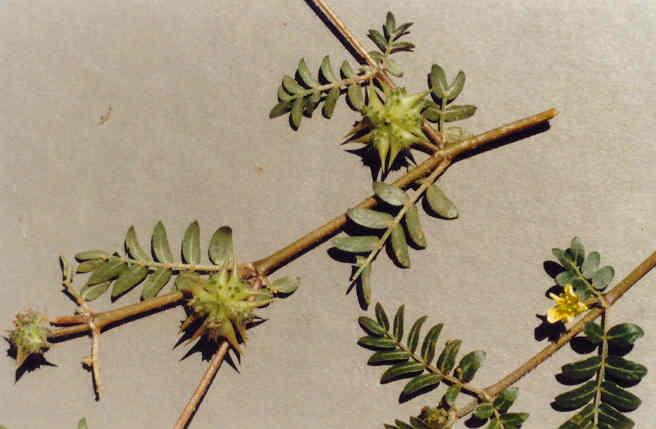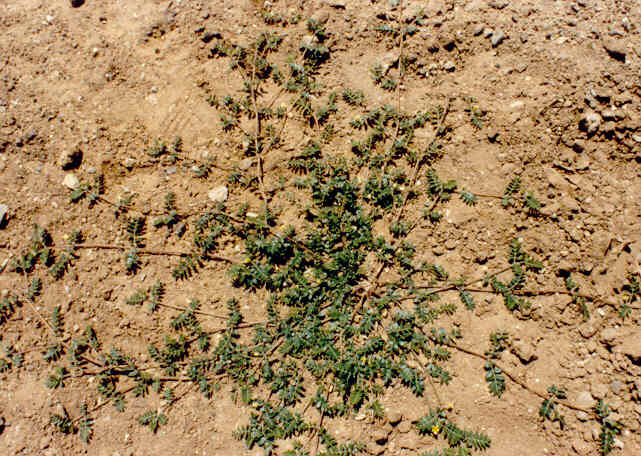
Tribulus terrestris L.
 |
Tribulus terrestris L.
Zygophyllaceae (Caltrop Family)Old WorldPuncture VineGoat's Head |
July Photo
Plant Characteristics:
Annual, trailing, pubescent, often prostrate, branched from base, the
stems 2-10 dm. long; lfts. 4-7 pairs, oblong or elliptic, 5-12 mm. long,
stipules 11-5 mm.; fls. solitary, axillary, (4-) or 5 merous; petals yellow,
obovate, 3-4 mm. long; fils. 10 (8), slender without appendages; carpels as many
as petals, crested and armed with 2-4 spreading gray or yellowish spines 4-6 mm.
long.
Habitat:
Naturalized in waste places, along roadsides, etc. through much of Calif.
below 5000 ft., even on the deserts; to Atlantic Coast.
April-Oct.
Name:
Latin name of caltrop, the shape of which is suggested by the
3-pronged fruit. (Munz, Flora
So. Calif. 862). Also, Greek, caltrop,
a weapon used to impede cavalry. (Hickman,
Ed. 1099; Tribulus is Latin for "three pointed."
(Dale 200). Latin, terrestris,
of or belonging to the earth. (Jaeger
260). The species name may refer to
the prostrate habit of the plant. (my
comment).
General:
Rare in the study area, having been found only once and this about 100
yards from Jamboree Rd. on the horse path built through Santa Heights in 1987.
(my comment).
The five nutlets equipped with 2-4 spreading spines fall apart at
maturity pointing one spine upward to be disseminated by animals, shoes or
rubber tires. Within the bur, the seeds lay one above the other, separated
by hard, horny tissue. The largest
germinates first and if there is only enough moisture for one, the others remain
dormant until a more favorable time. (Dale
200). The
root system of puncture vine consists of a simple tap root branching into a
network of very fine rootlets, which so surround the soil particles as to take
utmost advantage of the soil moisture. This
root habit enables the puncture vine to live under conditions of drought
survived by few other plants. The
petals are usually open only in the morning, closing shortly after noon, except
in cloudy weather. Mechanical
injuries to animals are frequent. Cattle,
horses, sheep, swine and dogs have all been known to receive wounds from
puncture vine burs. Mouth injuries
are occasionally noted, but not so frequently as might be presumed from the
prevalence of the seed in certain sections.
(Robbins, et al. 288,289).
Tribulus terrestris has been found to accumulate free nitrates in
quantities capable of causing death or distress in cattle.
(Fuller 384).
Long a pernicious weed, now controlled by introduced weevils.
Toxic to livestock in vegetative condition.
(Hickman, Ed. 1099).
Some rather extensive studies have shown that the seeds and to a lesser
degree, the foliage is a useful early treatment for elevated blood fats,
including cholesterols. It helps
prevent the severity of arteriosclerosis and atherosclerosis.
The reasonable dose is one-half to one teaspoon of the powdered plant in
hot water for tea, morning and early evening.
Puncture Vine is also useful in mild essential hypertension.
(Moore, Medicinal Plants of the Desert and Canyon West
96).
An extract of this common weed is gaining attention as a therapy for low
libido and sexual dysfunction. This
herb, which has been used for centuries in India and Eastern Europe, has been shown to increase
testosterone levels in men and women. The
plant has other benefits as well. It improves energy and mood and has been used
by body builders for its ability to improve muscle strength.
A less expected benefit is improvement of cholesterol levels.
(Holt. S. The Sexual Revolution. San Diego: Promotion Publishing
1999. An excerpt printed in Health and Healing, by
Dr. Julian Whitaker. July 2002 Vol. 12, No. 7
p.5).
Text Ref:
Dale 200; Hickman, Ed. 1099; Munz, Flora So. Calif. 862.
Photo Ref:
July-Aug 87 # 5,6.
Identity: by R. De Ruff.
Computer Ref: Plant Data 340.
Have Plant Specimen.
Last edit 7/18/03.
 |
July Photo